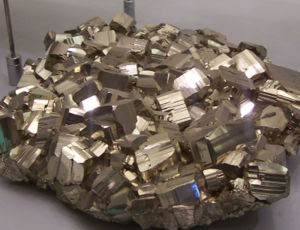
The mineral pyrite, or iron pyrite, is an iron sulfide with the formula FeS2. This mineral's metallic luster and pale-to-normal, brass-yellow hue have earned it the nickname fool's gold due to its resemblance to gold. Pyrite is the most common of the sulfide minerals.
Pyrite is usually found associated with other sulfides or oxides in quartz veins, sedimentary rock, and metamorphic rock, as well as in coal beds, and as a replacement mineral in fossils. Despite being nicknamed fool's gold, small quantities of gold are sometimes found associated with pyrite. Gold and arsenic occur as a coupled substitution in the pyrite structure. In the Carlin, Nevada gold deposit, arsenian pyrite contains up to 0.37 wt% gold. Auriferous pyrite is a valuable ore of gold.
Pyrite exposed to the atmosphere during mining and excavation reacts with oxygen and water to form sulfate, resulting in acid mine drainage. This acidity results from the action of Acidithiobacillus bacteria, which generate their energy by oxidizing ferrous iron (Fe2+) to ferric iron (Fe3+) using oxygen. The ferric iron in turn attacks the pyrite to produce ferrous iron and sulfate. The ferrous iron is then available for oxidation by the bacterium; this cycle continues until the pyrite is depleted.
Pyrite is used commercially for the production of sulfur dioxide, for use in such applications as the paper industry, and in the manufacture of sulfuric acid.
During the early years of the 20th century, pyrite was used as a mineral detector in radio receivers, and to this day is so used by 'crystal radio' hobbyists. Until the vacuum tube matured, the crystal detector was the most sensitive and dependable detector available- with considerable variation between mineral types and even individual samples within a particular type of mineral. The most sensitive mineral was galena, which was very sensitive also to mechanical vibration, and easily knocked off the sensitive point; the most stable were perikon mineral pairs; and midway between was the pyrites detector, which is approximately as sensitive as a modern 1N34A diode detector.
Pyrite has been proposed as an abundant inexpensive material in low cost photovoltaic solar panels.

The mineral pyrite, or iron pyrite, is an iron sulfide with the formula FeS2. This mineral's metallic luster and pale-to-normal, brass-yellow hue have earned it the nickname fool's gold due to its resemblance to gold. Pyrite is the most common of the sulfide minerals.
Pyrite is usually found associated with other sulfides or oxides in quartz veins, sedimentary rock, and metamorphic rock, as well as in coal beds, and as a replacement mineral in fossils. Despite being nicknamed fool's gold, small quantities of gold are sometimes found associated with pyrite. Gold and arsenic occur as a coupled substitution in the pyrite structure. In the Carlin, Nevada gold deposit, arsenian pyrite contains up to 0.37 wt% gold. Auriferous pyrite is a valuable ore of gold.
Pyrite exposed to the atmosphere during mining and excavation reacts with oxygen and water to form sulfate, resulting in acid mine drainage. This acidity results from the action of Acidithiobacillus bacteria, which generate their energy by oxidizing ferrous iron (Fe2+) to ferric iron (Fe3+) using oxygen. The ferric iron in turn attacks the pyrite to produce ferrous iron and sulfate. The ferrous iron is then available for oxidation by the bacterium; this cycle continues until the pyrite is depleted.
Pyrite is used commercially for the production of sulfur dioxide, for use in such applications as the paper industry, and in the manufacture of sulfuric acid.
During the early years of the 20th century, pyrite was used as a mineral detector in radio receivers, and to this day is so used by 'crystal radio' hobbyists. Until the vacuum tube matured, the crystal detector was the most sensitive and dependable detector available- with considerable variation between mineral types and even individual samples within a particular type of mineral. The most sensitive mineral was galena, which was very sensitive also to mechanical vibration, and easily knocked off the sensitive point; the most stable were perikon mineral pairs; and midway between was the pyrites detector, which is approximately as sensitive as a modern 1N34A diode detector.
Pyrite has been proposed as an abundant inexpensive material in low cost photovoltaic solar panels.








No comments:
Post a Comment